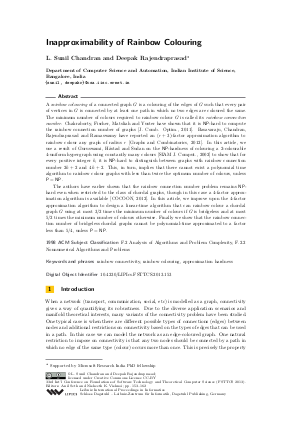Inapproximability of Rainbow Colouring
Authors L. Sunil Chandran, Deepak Rajendraprasad
-
Part of:
Volume:
IARCS Annual Conference on Foundations of Software Technology and Theoretical Computer Science (FSTTCS 2013)
Part of: Series: Leibniz International Proceedings in Informatics (LIPIcs)
Part of: Conference: IARCS Annual Conference on Foundations of Software Technology and Theoretical Computer Science (FSTTCS) - License:
 Creative Commons Attribution 3.0 Unported license
Creative Commons Attribution 3.0 Unported license
- Publication Date: 2013-12-10
File

PDF
LIPIcs.FSTTCS.2013.153.pdf
- Filesize: 433 kB
- 10 pages
Document Identifiers
Subject Classification
Keywords
- rainbow connectivity
- rainbow colouring
- approximation hardness
Metrics
- Access Statistics
-
Total Accesses (updated on a weekly basis)
0Document
0Metadata
Abstract
A rainbow colouring of a connected graph G is a colouring of the edges of G such that every pair of vertices in G is connected by at least one path in which no two edges are coloured the same. The minimum number of colours required to rainbow colour G is called its rainbow connection number. Chakraborty, Fischer, Matsliah and Yuster have shown that it is NP-hard to compute the rainbow connection number of graphs [J. Comb. Optim., 2011]. Basavaraju, Chandran, Rajendraprasad and Ramaswamy have reported an (r+3)-factor approximation algorithm to rainbow colour any graph of radius r [Graphs and Combinatorics, 2012]. In this article, we use a result of Guruswami, Håstad and Sudan on the NP-hardness of colouring a 2-colourable 4-uniform hypergraph using constantly many colours [SIAM J. Comput., 2002] to show that for every positive integer k, it is NP-hard to distinguish between graphs with rainbow connection number 2k+2 and 4k+2. This, in turn, implies that there cannot exist a polynomial time algorithm to rainbow colour graphs with less than twice the optimum number of colours, unless P=NP. The authors have earlier shown that the rainbow connection number problem remains NP-hard even when restricted to the class of chordal graphs, though in this case a 4-factor approximation algorithm is available [COCOON, 2012]. In this article, we improve upon the 4-factor approximation algorithm to design a linear-time algorithm that can rainbow colour a chordal graph G using at most 3/2 times the minimum number of colours if G is bridgeless and at most 5/2 times the minimum number of colours otherwise. Finally we show that the rainbow connection number of bridgeless chordal graphs cannot be polynomial-time approximated to a factor less than 5/4, unless P=NP.
Cite As Get BibTex
L. Sunil Chandran and Deepak Rajendraprasad. Inapproximability of Rainbow Colouring. In IARCS Annual Conference on Foundations of Software Technology and Theoretical Computer Science (FSTTCS 2013). Leibniz International Proceedings in Informatics (LIPIcs), Volume 24, pp. 153-162, Schloss Dagstuhl – Leibniz-Zentrum für Informatik (2013)
https://doi.org/10.4230/LIPIcs.FSTTCS.2013.153
BibTex
@InProceedings{chandran_et_al:LIPIcs.FSTTCS.2013.153,
author = {Chandran, L. Sunil and Rajendraprasad, Deepak},
title = {{Inapproximability of Rainbow Colouring}},
booktitle = {IARCS Annual Conference on Foundations of Software Technology and Theoretical Computer Science (FSTTCS 2013)},
pages = {153--162},
series = {Leibniz International Proceedings in Informatics (LIPIcs)},
ISBN = {978-3-939897-64-4},
ISSN = {1868-8969},
year = {2013},
volume = {24},
editor = {Seth, Anil and Vishnoi, Nisheeth K.},
publisher = {Schloss Dagstuhl -- Leibniz-Zentrum f{\"u}r Informatik},
address = {Dagstuhl, Germany},
URL = {https://drops.dagstuhl.de/entities/document/10.4230/LIPIcs.FSTTCS.2013.153},
URN = {urn:nbn:de:0030-drops-43689},
doi = {10.4230/LIPIcs.FSTTCS.2013.153},
annote = {Keywords: rainbow connectivity, rainbow colouring, approximation hardness}
}
